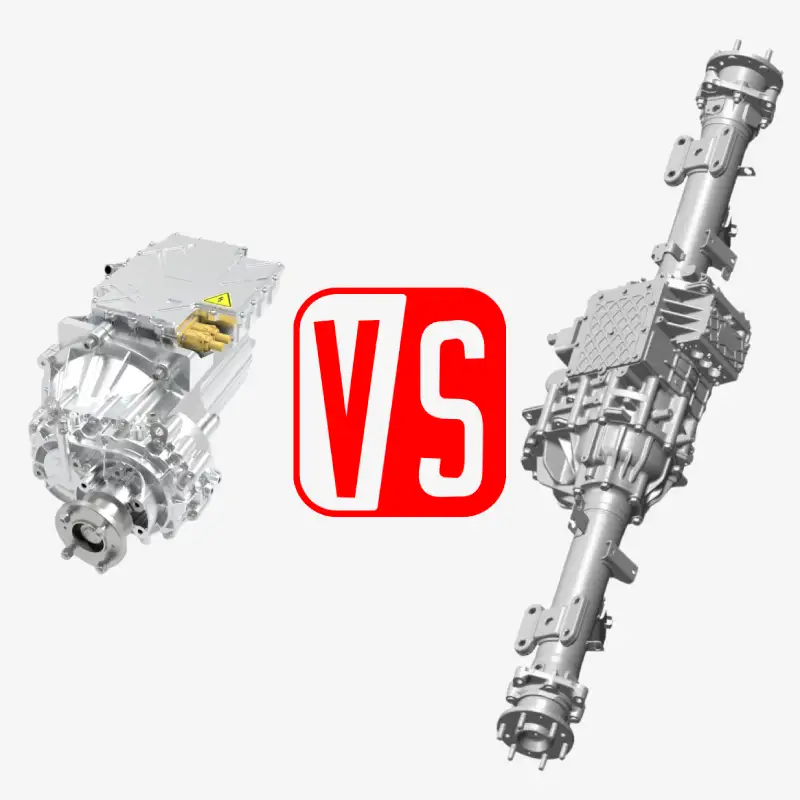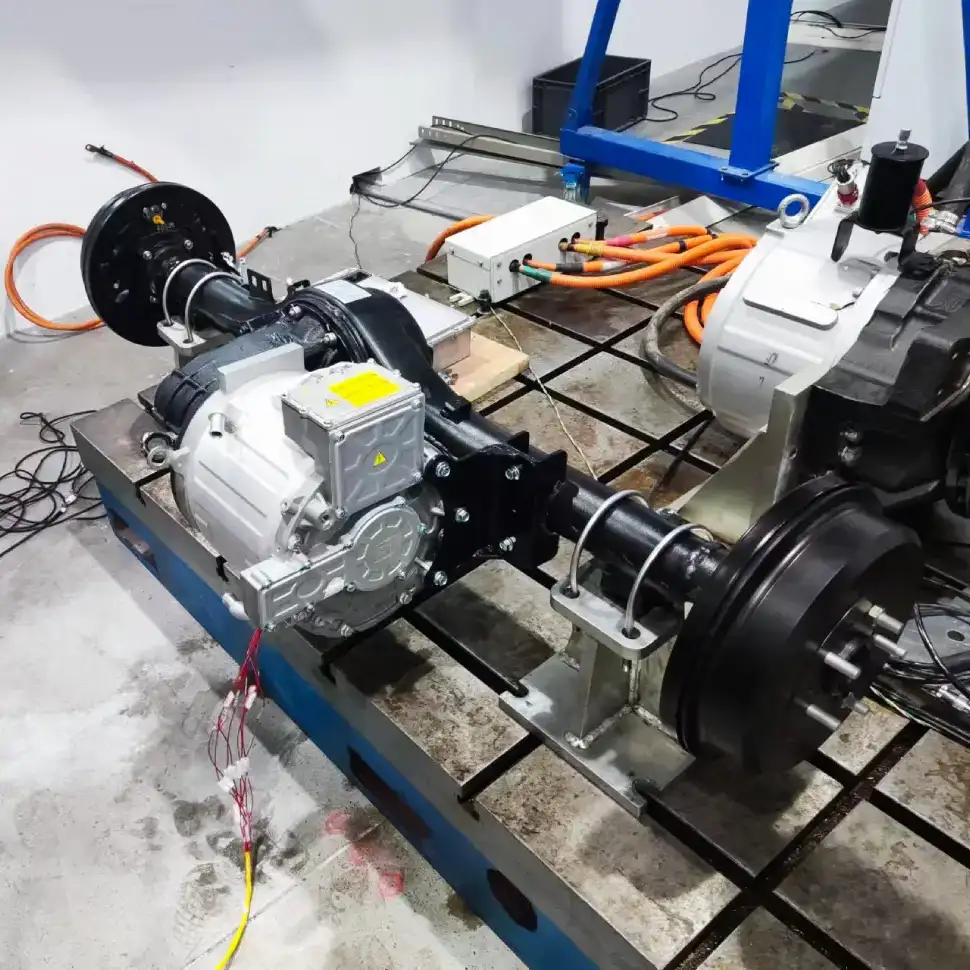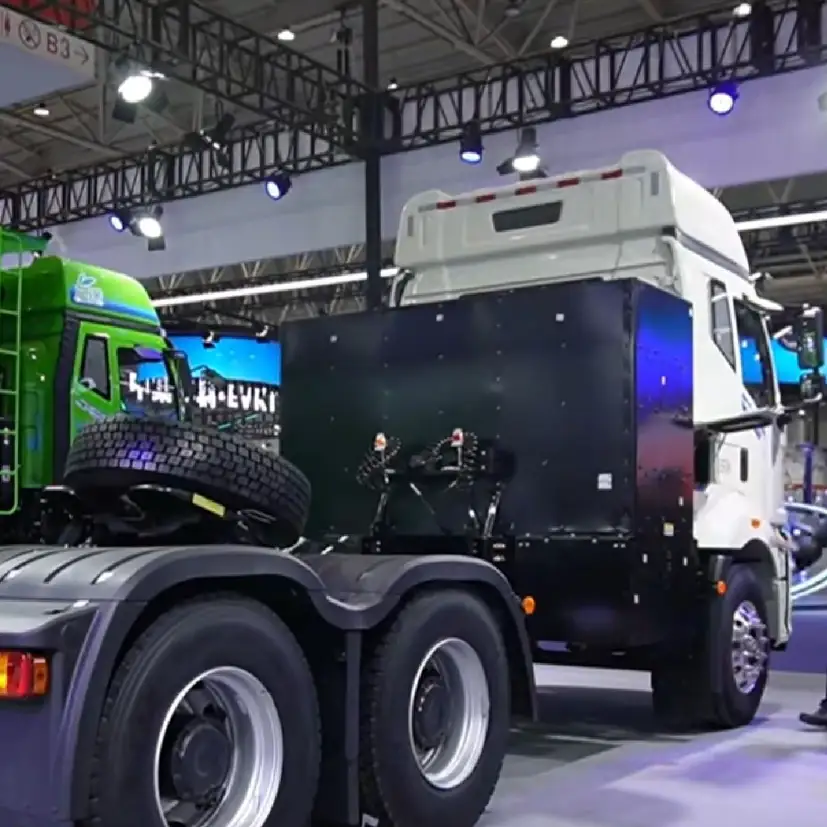Advantages and Challenges of Electro-Mechanical Braking (EMB) Systems in Commercial Vehicle Applications
Electro-Mechanical Braking (EMB) systems not only support brake-by-wire functionality but also redefine vehicle dynamics systems such as the Electronic Stability Controller (ESC). By advancing intelligent chassis control technology and chassis domain integration, EMB plays a crucial role in the evolution of smart mobility. While early challenges hindered its mass production, significant advancements in motor and transmission technology over the past two decades have accelerated the development of EMB, making large-scale production feasible.
Overview of Traditional Pneumatic Braking Systems in Commercial Vehicles
In medium and heavy-duty trucks, the pneumatic braking system consists of four main components: a high-pressure air source, an air processing system, an energy storage system, and a control system. While fuel-powered and new energy vehicles share similar braking system architectures, they differ in the air source mechanism.
- Fuel-Powered Vehicles: The air source is provided by an engine-driven air compressor, sharing intake, lubrication, and cooling systems with the engine. Maintenance aligns with engine service intervals.
- New Energy Vehicles: These require an electric air compressor, necessitating a separate intake, lubrication, and cooling system, which increases cost, weight, and maintenance complexity.
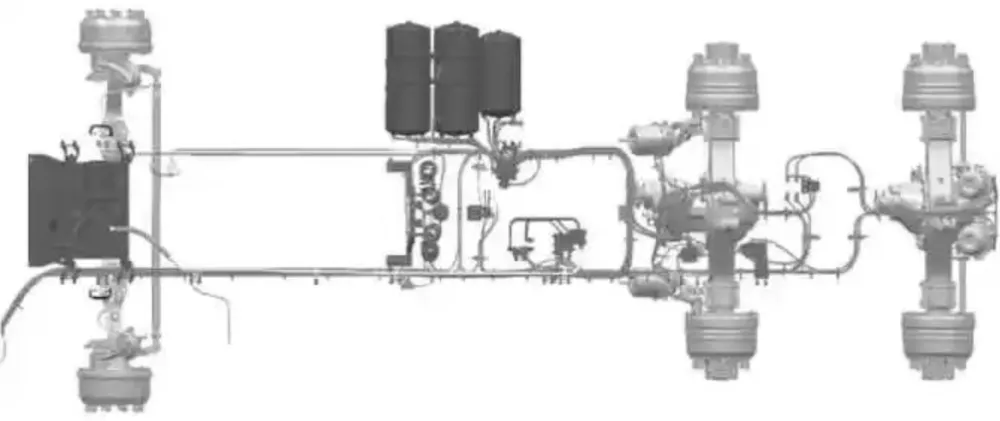
The air processing system ensures clean, dry air through desiccant filters, which require periodic replacement. The energy storage system consists of air reservoirs, equipped with drain valves to prevent moisture accumulation. The control system integrates various sensors and actuators to regulate braking operations. However, the complexity and maintenance demands of traditional pneumatic braking systems pose challenges, including frequent component failures, air leaks, and the need for routine maintenance of lubricants, filters, and drying units.
Introduction to EMB Systems
An EMB system consists of a driver input module, vehicle state sensors, axle control modules, and wheel-end actuators. Unlike traditional pneumatic or hydraulic brakes, EMB utilizes electric motors to actuate braking, eliminating the need for compressed air or hydraulic fluid.
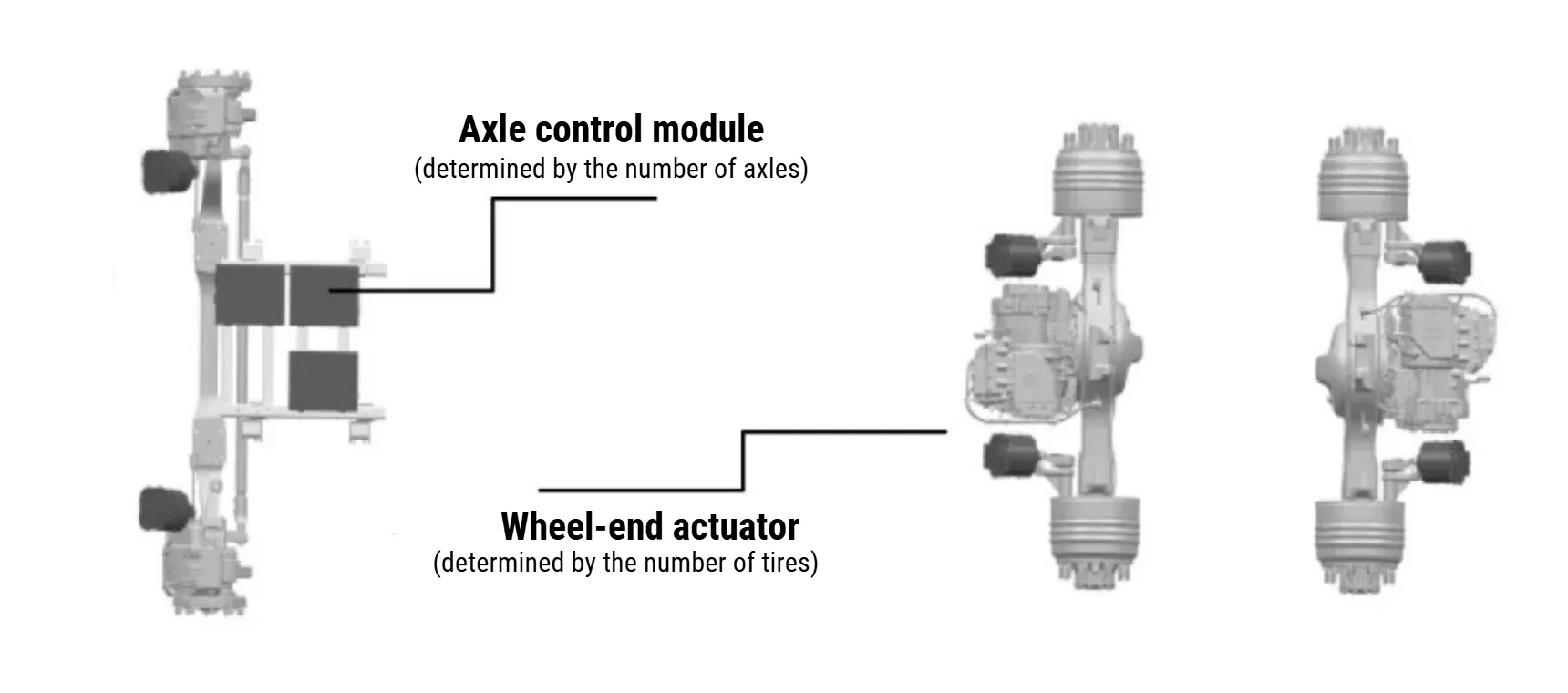
The driver input module captures braking commands through pedals and switches. Vehicle state sensors, including yaw rate and wheel speed sensors, collect real-time data. The wheel-end actuator, driven by an electric motor, replaces conventional pneumatic or hydraulic components to execute braking. The axle control module processes driver input and vehicle state information to control each wheel independently, enabling functions such as:
Brake-by-wire operation
Electronic Parking Brake (EPB)
Anti-lock Braking System (ABS)
ESC (Electronic Stability Control)
Acceleration Slip Regulation (ASR)
Hill-start assist
Regenerative braking
A typical EMB architecture consists of a power distribution and control module, which communicates with the vehicle’s CAN (Controller Area Network) bus to process driver inputs and vehicle state data. The system generates precise motor control commands, forming a closed-loop control mechanism for braking operations. To ensure redundancy, axle control modules communicate with each other, allowing backup operation in case of failure.
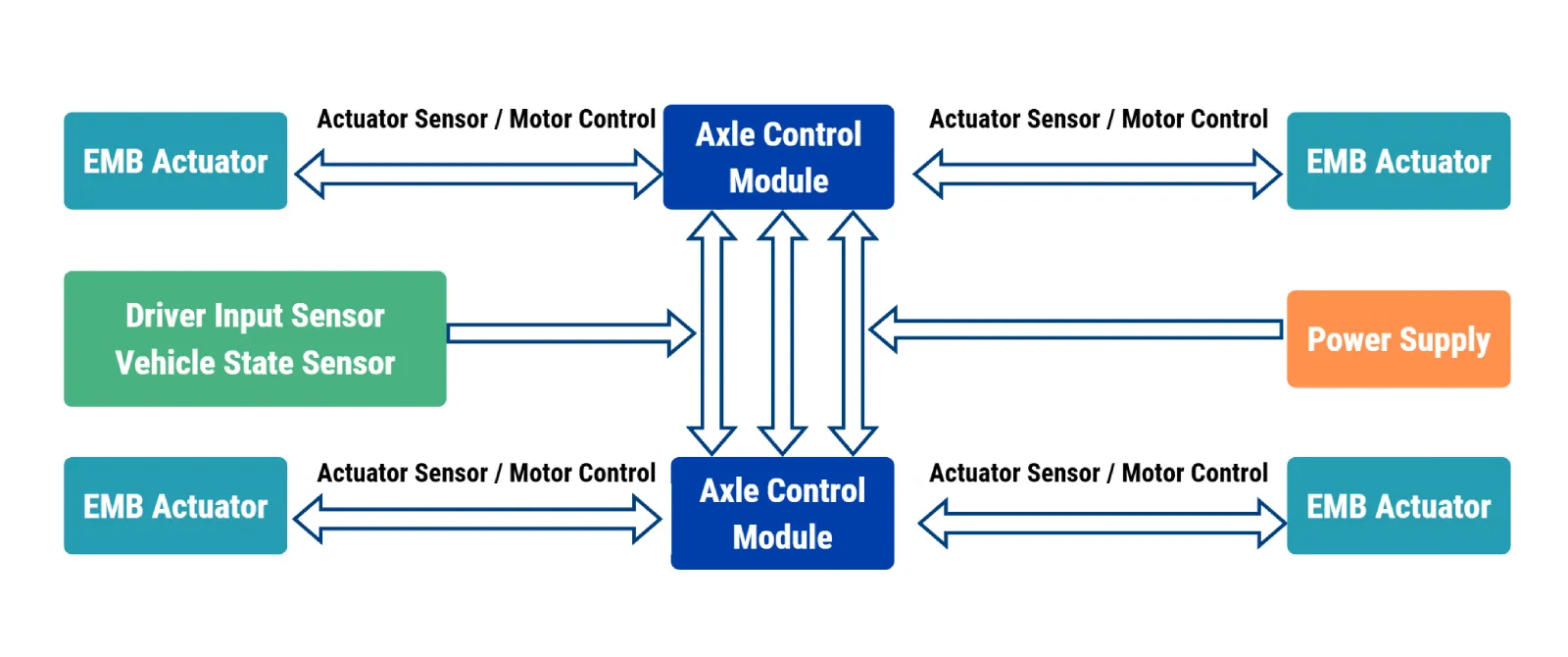
Advantages of EMB Systems
1. Environmental Benefits
EMB eliminates the need for air compressors and hydraulic fluids, reducing environmental pollution during production, use, and maintenance. This makes the vehicle’s lifecycle more eco-friendly.
2. Simplified Maintenance
Compared to traditional pneumatic systems, EMB reduces component count by 70%, simplifying system architecture and minimizing failure points. Eliminating air compressor maintenance, filter replacements, and drying unit upkeep significantly lowers operational costs and enhances vehicle uptime.
3. Lightweight Design
The modular EMB structure reduces system weight by approximately 100 kg. This weight reduction enhances vehicle load capacity, improves energy efficiency, and contributes to emissions reduction, aligning with the industry’s push for sustainability.
4. Enhanced Safety and Intelligence
EMB offers improved braking response times and precise control, reducing stopping distances and enhancing vehicle stability. The system’s independent wheel control mitigates skidding and enhances stability during emergency braking or on challenging terrain. Furthermore, in the event of steering failure, EMB can selectively apply braking force to assist with directional control.
5. Improved Energy Efficiency
Traditional pneumatic systems convert electrical energy into compressed air, resulting in energy losses. EMB directly converts electrical energy into braking force, improving transmission efficiency and reducing energy consumption by up to 50%. Additionally, EMB facilitates better integration with distributed drive systems, enabling more efficient regenerative braking, extending vehicle range, and prolonging brake component lifespan.
6. Enhanced Driving Comfort
By decoupling mechanical and electric braking, EMB allows precise calibration of brake pedal responsiveness, enabling personalized braking feel adjustments. This enhances driver comfort and improves brand perception.
Challenges of Implementing EMB in Commercial Vehicles
1. Electronic System Reliability
EMB is entirely dependent on electronic controls, making system failures a significant safety concern. Malfunctions in power distribution, controllers, or driver input sensors could lead to braking loss. To mitigate risks, redundancy must be built into power supply, sensor networks, and control modules. Advanced fault detection algorithms and rapid response mechanisms are essential for maintaining safety and reliability.
2. Balancing Cost and Reliability
Cost sensitivity in commercial vehicles is a major challenge. EMB requires significant investment in high-performance sensors, ECUs, and actuators. Additionally, redundancy designs to meet safety requirements further increase costs. Optimizing control algorithms and integrating vehicle resources efficiently will be key to making EMB competitive with existing EBS (Electronic Braking Systems).
3. Standardization Challenges
EMB technology is still in its early stages, lacking unified global standards. The primary reference is the ECE R13 regulation proposed by the European Automobile Parts Manufacturers Association. However, it does not provide clear redundancy requirements for intelligent or autonomous vehicles. Diverse technological approaches by different manufacturers have led to fragmented development. Industry collaboration is necessary to establish clear guidelines and accelerate standardization.
4. Dependence on Compressed Air for Other Vehicle Functions
In commercial vehicles, compressed air is used for auxiliary systems such as air suspension seats, cabin air suspension, pneumatic locking mechanisms, automatic transmission gear shifting, PTO (Power Take-Off) systems for lifting mechanisms, differential lock controls, and air horns. Transitioning to EMB requires alternative solutions for these functions, adding complexity to vehicle design.
Conclusion
EMB represents a groundbreaking advancement in commercial vehicle braking, offering significant benefits in efficiency, safety, maintenance, and environmental impact. However, challenges related to electronic reliability, cost, standardization, and auxiliary system integration must be addressed for widespread adoption. As technology progresses and industry standards evolve, EMB has the potential to redefine commercial vehicle braking, paving the way for smarter and more sustainable transportation solutions.
